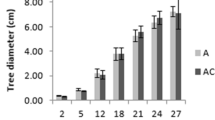Abstract
Two projects on alley cropping research and development have been implemented in the Forest zone of Cameroon (FZC) since 1988. Their goal was to identify the main agricultural constraints in the FZC and to introduce alley cropping in the farming systems to improve soil fertility and crop yields.
The first step in the implementation process was the participatory surveys which revealed that (a) the main agricultural constraint in the FZC is low soil fertility; (b) alley cropping is an agroforestry technology which may solve the problem; (c) alley cropping should be first targetted to farmers who own inherited or purchased lands.
The second step was the on-station tree screening activity from which Leucaena leucocephala, Gliricidia sepium, Calliandra calothyrsus and Paraserianthes falcataria were identified as promising tree species.
The third activity was to test alley cropping with three promising tree species (Leucaena, Gliricidia and Calliandra) on farmers' fields. Results from the first year testing on farmers' fields showed that: (1) the direct seeding method used was ineffective: seedling emergence rate was 45% for Leucaena and 52% for Gliricidia; (2) Cassava suppressed the growth of Leucaena and Gliricidia by 57 and 45%, respectively; (3) three-month-old Calliandra seedlings planted 1 m away from cassava plants had 96% survival rate. Based on these third step findings, all new farms were established with Calliandra seedlings using maize as a test-crop in the year of establishment and the subsequent year. After two years of cropping, maize grain yield in alley plots was 52% higher than maize grown on no-tree plots.
In 1993, 52 farmers who had witnessed the alley farm maize growth in 1992 requested to join the project. This sudden interest of farmers to start their own alley farms was considered as a positive sign for adoption and therefore a success in alley cropping (AC) introduction in the zone.
Similar content being viewed by others
References
Atta-Krah AN and Sumberg JE (1988) Studies with Gliricidia sepium for crop/livestock production systems in West Africa. Agroforestry Systems 6: 97–118
Duguma B, Tonye J and Depommier D (1990) Diagnostic survey on local multipurpose trees/shrubs, fallow systems and livestock in Southern Cameroon. ICRAF Working Paper No. 60, 42 pp
IRA/ICRAF Project (1988) Diagnostic and design survey in the forest zone of Cameroon. Rapport annuel du Project IRA/ICRAF. Institut de la Recherche Agronomique. Yaounde, Cameroon, 112 pp
Kang BT, Reynolds L and Atta-Krah AN (1990) Alley farming. Adv Agron 43: 315–359
Omoko M (1984) Dynamique de l'eau dans un sol ferrallitique et étude comparée entre l'évapotranspiration mesurée et calculée en climat tropical. Thèse de Doctorat 3è cycle. Université de Bordeau, France, 125 pp
Onguene (1987) Transformation d'un sol rouge dans le domaine aval d'une topséquence dans la région de Yaounde. Mémoire de DEA. Université de Pierre et Marie Curie, France
Tonye J, Ambassa-Kiki R and Nsangou M (1988) Description des systèmes d'utilisation des terres dans la zone forestière du Cameroun. Possibilités d'amélioration. Science et Technique 3(1): 31–43
Tonye J, Meke-me-ze C and Titi-Nwel P (1993) Implication of National land legislation and customary land and tree tenure on the adoption of alley farming. Agroforestry Systems 22: 153–160
Author information
Authors and Affiliations
Rights and permissions
About this article
Cite this article
Tonye, J., Duguma, B. & Tiki-Manga, T. Stepwise approach to alley cropping technology development and transfer in the forest zone of Cameroon. Agroforest Syst 28, 269–278 (1994). https://doi.org/10.1007/BF00704760
Issue Date:
DOI: https://doi.org/10.1007/BF00704760



